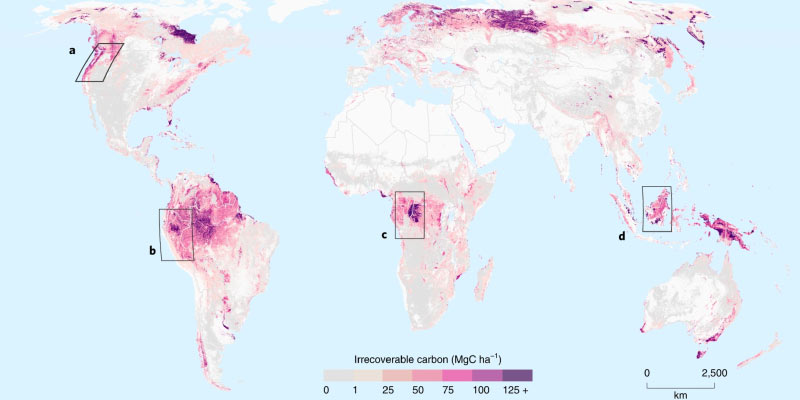
Tropical forests of the Amazon and temperate forests of northwestern North America are just a few of the Earth’s ecosystems that contain climate-critical stores of carbon. They withhold large amounts carbon from the atmosphere that has been identified as irrecoverable; that is, carbon that is vulnerable to release from human activity and, if lost, could not be restored by 2050 — when the world must reach net-zero emissions to avoid the worst impacts of climate change. This concept was first proposed in a 2020 paper involving scientists from the University of Wisconsin-Madison and this November, they followed up that report with a paper mapping all irrecoverable carbon.
Published in Nature Sustainability the map and accompanying paper was led by scientists at Conservation International along with UW-Madison graduate research assistant, Seth Spawn-Lee. A member of the Gibbs Land Use and Environment Lab within the Nelson Institute Center for Sustainability and the Environment (SAGE), Spawn-Lee’s research works to better understand the environmental and earth-system impacts of land-use change.
The irrecoverable carbon mapping project is an extension of Spawn-Lee’s previous work mapping the carbon stored in the world’s plants and assessing how those stores are effected by land use changes, such as when a forest is converted for agriculture or another use.
“Land use change is one of the main sources of climate-warming greenhouse gas emissions—second only to fossil fuel burning,” said Spawn-Lee. “The ‘irrecoverable carbon’ concept is meant to help prioritize conservation efforts aimed at reducing these emissions.”
Among the key findings of this paper is that 75 percent of Earth’s irrecoverable carbon and habitat for 91 percent of the Earth’s terrestrial vertebrate species can be found in less than 14 percent of Earth’s land. This showcases the immediate need to protect this land.
As such, the report offers recommendations for supporting the management of this land. These recommendations include supporting Indigenous peoples and communities, who manage more than a third of Earth’s irrecoverable carbon, reversing policies and practices that threaten Earth’s last remaining irrecoverable carbon reserves, and designing comprehensive and collaborative land use planning practices that promote sustainable development and climate change resilience.
“Right now, countries the world over are pledging to protect as much as 30 percent of the earth’s land area by 2030 in hopes of preserving both biodiversity and a habitable climate,” said Spawn-Lee. “Our map can inform these efforts by identifying the places we simply can’t afford to lose and that urgently deserve uncompromising protections.”